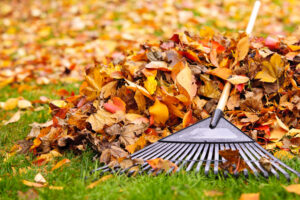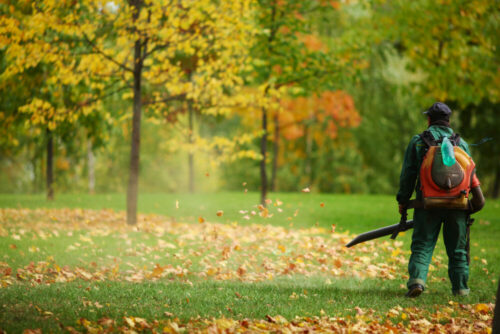The Importance Of Fall And Winter Leaf Cleanup On Your Lawn
 It is easy to develop a bit of a love/hate relationship with the leaves in our garden. They can provide shade while on the tree in summer, look beautiful as the colors change, and then give the kids and dogs something fun to play with. However, fallen leaves aren’t fun for long and they can pose a risk to your lawn. So, why is regular leaf cleanup in fall and winter so essential, and what is the best approach?
It is easy to develop a bit of a love/hate relationship with the leaves in our garden. They can provide shade while on the tree in summer, look beautiful as the colors change, and then give the kids and dogs something fun to play with. However, fallen leaves aren’t fun for long and they can pose a risk to your lawn. So, why is regular leaf cleanup in fall and winter so essential, and what is the best approach?
The simple answer is that a heavy build-up of fallen leaves does more than create an eyesore on your lawn. These thick layers can stifle the development of the grass and put it at risk of disease. Once spring rolls around again, your lawn might not be in prime condition if you left the leaves to rot over winter. The good news is that you can prevent damage through regular leaf cleanup and maintenance.
Why is fall and winter leaf clean-up so important?
You might decide to remove leaves now and then when the lawn starts to look untidy, but it is important to rake your lawn regularly to improve its health. The right raking system can also help you put those leaves to good use. Homeowners can enjoy a cleaner, more productive garden if they do the following:
~ rake the leaves regularly in fall to stop pests and mold building up
~ rake the leaves regularly in winter to let in as much light as possible
~ prevent heavy build-ups of leaves that might lead to stunted grass blades
~ make good use of the leaves through mulching and composting
~ turn this into a simple, regular habit that doesn’t impose on others
Fall leaf cleanup can stop mold and pests from getting into the lawn.
Leaf litter can be a great thing for wildlife in the right area. Some fallen leaves around bushes and undergrowth are great cover for insects and small mammals. So, it might help to leave any fallen leaves in these areas if you want a more natural garden. However, leaf litter on the lawn may bring in pests and disease and put the grass at risk.
One issue to be aware of here is the risk of mold. Snow mold and brown patch can develop when giving the appropriate conditions in the decaying leaves. These diseases will then infect the grass and could make their way through the lawn. This could go on, undetected for a long time, which could then mean costly treatments for your damaged lawn in spring. Prevention is better than the cure, so make sure to remove leaves before the mold can settle in.
Winter leaf cleanup can allow the lawn to breathe and get more light.
A heavy layer of leaves on your lawn could become a dangerous shield between your grass and all the life-giving elements and nutrients it needs. Your lawn is tough, but it still needs light, air, water, and nutrients to survive. Leaf litter could prevent access to them all.
Water could collect on the leaves and not make it down to the root system, leading to dehydration. Precious sunlight for photosynthesis might not reach the leaves. This is particularly problematic during the winter when sunlight may be scarce anyway. You might say that your lawn doesn’t need so much care in the winter. But, it will store energy from light during dormancy ready for the spring.
Heavy loads of leaves can stunt the growth of your lawn.
Ideally, you want fresh, erect green blades of grass on your lawn in the spring. You get a nice dense carpet that is appealing to look at, comfortable to sit on and easy to mow to just the right length. However, this perfect uniform carpet may not appear if you don’t deal with the fallen leaves. Winter and fall leaf cleanup operations can help to maintain the shape of your lawn. Thick mats of decaying leaves might block the growth of new grass blades over these seasons.
What is the best way to remove leaves from your lawn?
The next factor to consider is the best tool for leaf cleanup in your garden. While some people will instinctively reach for a leaf blower, the rake is the better option. Leaf blowers seem like they should be the more effective option. You pull the cord for the motor and blast air at the leaves to get them off the lawn. One problem is that you don’t have much control over the direction of the leaves. It isn’t so easy to create a nice neat pile. The other issue is the noise generated. If you have ever cursed a neighbor for using a lawnmower or strimmer at an inappropriate time then you know that they won’t appreciate you using a leaf blower.
This means that the rake is the best tool for cleaning up leaves on a lawn. While it does require more physical labor, you should get a better result and it might save some time. A rake lets you apply the right pressure to the lawn to drag out all the leaves and other debris. You can work methodically in a satisfying way. Also, as long as the rake isn’t too big or heavy, it should be fairly child-friendly too.
How often should you rake your lawn?
The frequency of your lawn leaf cleanup operations will depend on the size of the problem. If you only have one tree that sheds a little at a time, you might be able to wait a while until there is a decent amount on the lawn. It isn’t worth the effort to rake a tiny amount every few days. But, if you multiple trees shedding frequently, you may need to get out there more often. The species of tree can make a difference too. It doesn’t take many maple leaves to cover a sizeable patch of grass, whereas the same number of birch leaves aren’t such a problem.
There is no point in doing this too often if there is minimal coverage. But, you don’t want to leave it too long and have thick layers decaying and blocking light and air. Keep an eye on things and work out the most efficient approach for you.
What should you do with the leaves after you rake them?
You’ve got your leaves in a nice little pile and are satisfied with your efforts. But what do you do now? Depending on the size of your lawn, you could have a substantial pile there. It might be tempting to let the kids and dog play it in. There are certainly plenty of YouTube videos of pets diving into leaf piles to emulate. But, this is just going to create more mess. You might decide to leave the pile there. But, a good breeze is going to mess it all back up and you may still damage the lawn underneath. The best choice is to remove them all and there are two options here.
You could collect up all the leaves and put them in the trash. It is understandable why some homeowners would do so to stay as tidy as possible and feel like they completed the chore. But, this is actually a waste of a helpful natural material. Those leaves could break down into much or compost in the right container. Therefore, you can use the organic matter to feed your plants in the spring and turn this decomposition from a negative to a positive.
Frequent leaf cleanup sessions in fall and winter should allow for a better-looking lawn in spring.
In short, there are two key reasons for keeping up with lawn leaf cleanup in your garden. One is aesthetic and the other relates to the health of the lawn. We want our lawn to look at its best year-round and piles of leaf litter will hide the grass and potentially stunt its growth for spring. The long-term impact on the visual appeal of the lawn could be substantial.
Then there is the health and well-being of the lawn. That stunted growth is the result of poor health. Once you deprive the grass of sunlight, water, and nutrients you put it at risk of ill-health and death. It may recover with time, but it isn’t worth the risk. Remove the barriers and the reason for any disease and you can protect your lawn with ease.
Fall and winter leaf cleanup may be a literal chore, but it is worthwhile.
You may end up with a few arguments over who in your family has the task of clearing up the fallen leaves. Kids might appreciate the chance to earn some allowance money, but you need to be sure they will do a good job and compost the leaves afterward. If you would rather call on a professional to come and take care of the problem, you can contact us to find out more. Remember that the short-term cost of maintaining the lawn is better than finding out you damaged your lawn come spring.

